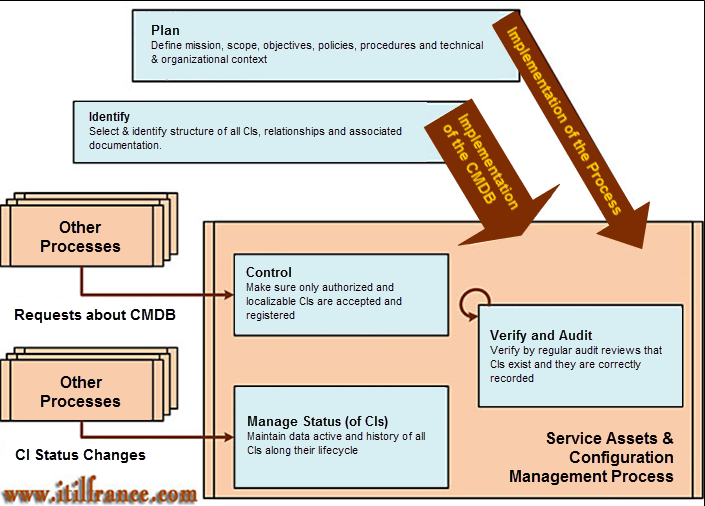Table of contents
Related Articles
Introduction
Service Asset and Configuration Management process is closely related to Change Management and Release and Deployment Management processes. The implementation cost and the IT ressource implication could be significant, and configuration items maintenance must be rigorously applied to keep a reliable information. The initial implementation of the process usually starts with the integration of assets (hardware and software) and services / assets that are critical for the business or depend on a law or a regulation.
Definitions
We invite you to consult ITIL® Glossary, section Service Asset and Configuration Management.
For simplicity and brevity purpose, we will use the term SACM, the official ITIL® abbreviation for Service Asset and Configuration Management.
Goal and Objectives
The goal of SACM is to ensure that the assets required to deliver services are properly contrôled, and that accurate and reliable information about those assets is available when and shere it is needed. This information includes details on how the assets have been configured and the relationships between them.
- CI integrity and configuration must be protected
- All CIs are centralized in the Configuration Management System (CMS)
- Must support efficiently the other operational processes
Scope
By definition, an asset means "any resource or capability". Assets implicated in service delivery are identified as configuration items (CI); CIs can be physical (computer, server) or logical (application, documentation, process). Thus, we can state that each CI is an asset, but certain assets are not necessarily CIs; for example, the knowledge used by a Service Desk employee to manage incidents is an asset but is in no way a CI.
The SACM scope includes the entire lifecycle of each CI participating in IT service delivery.
Value
- Optomizing service assets and configuration performance improve the global performance of IT services and optimize costs and risks caused by poorly managed assets
- IT staff better understands services, physical and logical infrastructure supporting them, and any other asset that could be implicated in service delivery
- Acces to a centralized information is easier
- It benefits from improved analysis, planning and delivery of changes and deployments
- It is easier to respect incident and problem resolution delays
Basic Concepts
Configuration Model
Service Asset and Configuration Management delivers a model of the services, assets and the infrastructure by recording the relationships between CIs. This enables a better assessment of outage impacts, change impacts, a better planning of technology refresh and software upgrades, and an optimization of assets utilization and costs.
The configuration items and their information can have different levels of details. The general rule is to not include attributes or relationships unless they create more value than the cost associated with maintaining them.
Configuration Items
A configuration item (CI) is a service asset that needs to be managed in order to deliver an IT service. The configuration items can vary widely in complexity, size and type, ranging from an entire service or system including all hardware, software, documentation to a single software module or a minor hardware component. They may be grouped and managed together, e.g. a set of components may be grouped into a release.
There is a variety of CIs, and every organization will decide whether each of these is a configuration item or simply an attribute of a configuration item (or even something that they do not need to manage). In addition, a change to a CI should be authorized by change management and the configuration item record updated. A control should be in place to ensure information integrity. Relationships should exist between CIs and with requests, such as incidents, problems, changes, etc.
The configuration information is saved in a CMDB. They can come from different data sources (finances, human resources) in order to create a federated CMDB. Every source will depend on the business unit that is responsible to , which sould be responsible for making it available and keep it updated; agreements are to be expected in this regard. Data loading and updating automations should be implemented where possible to reduce errors and optimize maintenance costs. Discovery tools, inventory and verification tools, network management tools and enterprise systems can be interfaced.
Configuration Baseline
A configuration baseline is the configuration of a service, a product or an infrastructure that "captures" the structure, the content, the details and the relationships between CIs. It provides the ability to mark a milestone in the development of a service, build a service from a defined set of inputs, change or rebuild a specific version at a later date, assemble all relevant components in readiness for a change or a release or provide the basis for a configuration audit and back-out, in the case of a change, for example.
Process and Activities
Asset Management
Fixed assets are assets that have a financial value, that can be used by the organization to create products or services and that have a long-term active life. For IT, it could include data centers, servers, software licenses, network components, computers, databases, etc.

Thank you, your message has been sent.
